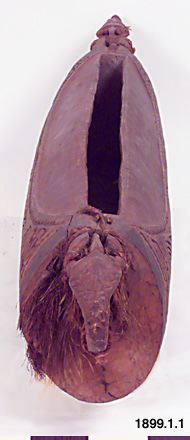Umbuŋ ‘Slit-drum’
- Description:
- Umbuŋ or TP garamut ‘slit-gong’ is an ideophone, made from the hollowed trunk of a tree with the same name. Umbuŋ, TP garamut (Vitex cofassus) is a tree with hard rot-resistant wood. It is also one of the few woods that are not eaten by termites. That is why we can see very old slit drums around in the villages, and in Awiakay land also in bush camps and in ancestral places. For the Awiakay, a slit-gong can be just an object, or it can embody a spirit, usually the main spirit of a clan’s men’s house. In such a case a slit-gong has a name, such as Wasim umbuŋa ‘Wasim spirit slit-gong’. In warfare times the Awiakay used to make cuts on their spirit slit-gongs, each cut representing a killed enemy. In this way the killed enemies were ‘offered’ to the spirit who’d given the Awiakay warriors the strength to kill them. In 2009 such marks could still be seen on the oldest slit-gong in the village. The spirits of slit-gongs remain present even if the physical object no longer exist. However, people can, at any point, decide to carve another slit-gong in place of an old or destroyed one, and perform a simple ritual in which to ‘redirect’ the spirit into the new slit-gong. People’s recent alienation from spirits (following the uptake of a Catholic charismatic movement in the mid 1990s) has also meant a decline in the importance of objects connected with the spirits. Apart from slit-gongs these were also bamboo flutes which were played in the men’s house during the initiation rite to represent the sound of spirits, and posts in the men’s house. Such objects have been left to decay, with new ones usually made just for everyday use. While communities of the Middle Sepik are renowned for elaborate wood carvings, Awiakay artifacts are less ornate. Only some older slit-gongs are elaborately carved, usually ones that are the embodiment of spirits and carry their names, while others have simpler (if any) carved designs. Slit-gongs are used both for signaling and in singsing (singing and dancing). The most common signal is that of an upcoming announcement, which reminds people to pay attention to what will be said. Another common signal calls people for a meeting, these days even for church services. However, slit-gongs are not only used for simple in-village announcements. As they can be heard far away, reaching far into the mountains in the south of Awiakay land, they can convey more elaborated messages to people in bush camps. Each totemic clan has its own drum signal, which is beaten on a slit drum to send a message to those who are in the forest. In addition to that, there are signals for men and for women, those announcing death, or the arrival of enemies. There are only few people left who know all the signals, people in a bushcamp sometimes misinterpret a slit-gong message from the village. However, they all recognise the sounds for death and danger, both of which mean that they must immediately return to the village. In the past, slit-gong signals were also used in post-mortem divination, when the spirit of the deceased was contacted in order to find out who was responsible for his or her death (for details on Awiakay slit-gong signals see Hoenigman 2007: 213-214; see also Telban 1998: 189-93). This string figure represents a slit-drum. Some makers ‘play’ it when the figure is finished, and then tell that they are now turning it into Wasim spirit drum. Images: 02: umbuŋ ‘slit drum’, final design of the string figure 03: Nason Olomaŋey with a slit drum Hoenigman, D. 2007. Language and Myth in Kanjimei, East Sepik Province, Papua New Guinea. MA thesis, Ljubljana: Institutum Studiorum Humanitatis, Ljubljana Graduate School of the Humanities. Telban, Borut. 1998. Dancing through Time: A Sepik Cosmology. Oxford: Oxford University Press. . Language as given: Awiakay. You can access this item at the PARADISEC website. You will need to sign up or sign in first.
- Format:
- MovingImage
- Collections:
- PARADISEC Catalog
- Contributors:
- Darja Hoenigman
- Content partner:
- PARADISEC
- Availability:
- Not specified
-
Copyright status: All rights reservedFind out more about what you are able to do with this itemThis item is all rights reserved, with means you'll have to get permission from PARADISEC before using it. For more information, please see our use and reuse page.More informationPARADISEC has this to say about the rights status of this item:
Open (subject to agreeing to PDSC access conditions)
What can I do with this item?Non-infringing useNZ copyright law does not prevent every use of a copyright work, and this item may be hosted by an international institute or organisation. You should consider what you can and cannot do with a copyright work.No sharingYou may not copy and/or share this item with others without further permission. This includes posting it on your blog, using it in a presentation, or any other public use.No modifyingYou are not allowed to adapt or remix this item into any other works.No commercial useYou may not use this item commercially.
Welcome and warm Pasifik greetings
The information on this site has been gathered from our content partners.
The names, terms, and labels that we present on the site may contain images or voices of deceased persons and may also reflect the bias, norms, and perspective of the period of time in which they were created. We accept that these may not be appropriate today.
If you have any concerns or questions about an item, please contact us.
